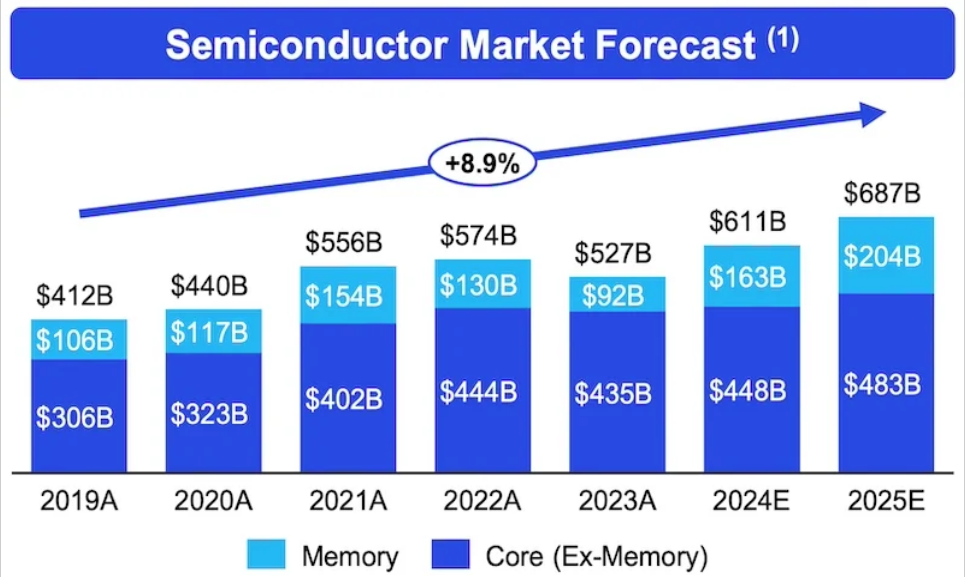As the global semiconductor industry enters 2025, the development prospects of the industry are full of opportunities and challenges. From technological innovation to market turmoil, the semiconductor industry is going through a critical period of transformation. Building on the significant growth achieved in 2024, 2025 will be a year of technological breakthroughs and market uncertainty. Here's an in-depth analysis of what's to come.
Strong growth in 2024
In 2024, the global semiconductor industry ushered in a strong recovery, with sales reaching $627 billion, up 19% year-on-year. This is mainly due to the rapid growth of the memory chip and logic chip market. In the storage space, the surge in demand for high-bandwidth memory (HBM) is driving the development of AI accelerators and data-intensive workloads. At the same time, the demand for logic chips in computing and IoT devices has also risen steadily, growing by 16.9%.
The performance of each region also has its own bright spots. The North American market was particularly strong, with a 38.9% increase, closely linked to the region's increased investment in advanced manufacturing capabilities and design innovation. The Asia-Pacific region, which is an important base for global semiconductor production, grew by 17.5%, driven by demand for consumer electronics, automotive applications, and IoT technologies.
In addition, 2024 has also witnessed large-scale consolidation and mergers and acquisitions in the industry. Large-scale mergers and acquisitions such as Sanofi's acquisition of Ansaith and Cadence's acquisition of BETA CAE show that semiconductor companies are enhancing their competitiveness through resource integration to cope with increasingly fierce market competition.
2025: Technological innovation drives the future
Looking ahead to 2025, the potential for innovation in the semiconductor industry is huge. Several key technology trends will lead the industry in the coming year.

Figure: Semiconductor market forecast (Source: KPMG)
2. Breakthrough in nanometer process technology
The introduction of 2nm Gate-All-Around (GAA) chips marks a further downsizing of the semiconductor technology node. This technology will deliver higher performance and energy efficiency, which is critical for AI workloads and next-generation computing needs. The production capacity of 2nm chips is expected to increase by 17%, greatly driving the development of advanced computing applications.
The rise of the Internet of Things and edge computing
With the proliferation of IoT devices and edge computing solutions, the demand for small, efficient devices is increasing dramatically. By moving data processing closer to the data source, IoT and edge computing can not only reduce latency, but also significantly improve energy efficiency, which is critical for battery-powered devices and industrial applications.
The demand for high-bandwidth memory has skyrocketed
With the rapid growth of the AI accelerator and GPU market, the demand for high-bandwidth memory will continue to rise. The HBM market is expected to grow by more than 24 percent, a change that is driving the demand for specialized chips and advanced packaging technologies.
Accelerating development of 5G and 6G technologies
5G and early-stage 6G technologies will continue to drive innovation in RF components, baseband processors, and network infrastructure. The need for efficient wireless connectivity is driving massive investments in these areas, especially when companies like Qualcomm accelerate their presence in this area.
Pioneering of emerging technologies
Emerging technologies such as silicon photonics, wide bandgap semiconductors such as GaN and SiC, and neuromorphic computing are opening new doors for the semiconductor industry. Silicon photonics works by integrating optical components into chips to enable faster data transmission; Wide bandgap semiconductors, on the other hand, have revolutionized power electronics by making electronic devices smaller and more efficient. Inspired by the human brain, neuromorphic computing promises breakthroughs in AI performance and energy efficiency.
Industry challenges and uncertainties in the future
Despite the huge potential of technological innovation, the semiconductor industry still faces some challenges in 2025, especially in terms of supply chains, economic environment, and geopolitics.
Supply chain imbalances
With the successive production of new chip fabs, there may be an oversupply in some markets, especially in the field of bulk memory chips. This will lead to price pressures and margin fluctuations, and companies must accurately forecast demand and balance production and sales.
Economic and policy implications
Factors such as the global economic situation, industrial subsidy policies, trade tariffs, and interest rates will have a significant impact on the growth of the semiconductor industry. For example, some subsidy policies in the United States and Europe are aimed at reducing dependence on imports and boosting local production, but their long-term effects are unclear.
Geopolitical risks
With the increasing importance of the semiconductor industry, the impact of international political factors on the market is becoming more and more significant. The stability of the global supply chain and trade policies will be the key factors affecting the future trend of the industry.
Coexists of innovation and uncertainty
In 2025, the semiconductor industry will continue to move forward on the path of innovation. Technological breakthroughs, such as 2nm processes, high-bandwidth memory, and the proliferation of IoT and edge computing, will drive the depth of the industry. However, the global economic situation, supply chain management, and geopolitical risks will also continue to have a profound impact on the industry. Companies must remain agile and adapt to market changes and find a balance between technological innovation and challenges.
Industry giants like Nvidia, Samsung, Intel, and TSMC will continue to drive the industry as the market becomes more competitive, and new technological frontiers will continue to expand the possibilities of the semiconductor industry.
Original:Forecasts for 2025 Semiconductor Growth Teeter on Several Factors






